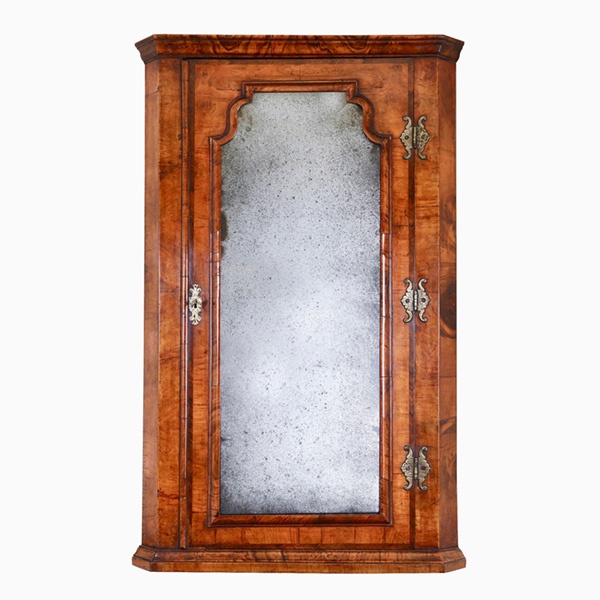Signed Mid 19th C. Edo/Meiji Period Diminutive Lacquer Stacking Cabinet, Japan
£5,800
Request Information
Follow Us
Signed Mid 19th C. Edo/Meiji Period Diminutive Lacquer Stacking Cabinet, Japan
The highly decorated tray in the form of a table frames a series of three stacking boxes, a further three lidded boxes and a tray concealed within, raised on ogee bracket feet.
This fine lacquer stacking cabinet of gold and black is a variation on a cabinet for incense. It contains small boxes within boxes to hold incense woods and an outer tray in the form of a table with legs.
All of the original eleven components are present.
The opening up of Japan in the mid-1850s after more than two centuries of seclusion from the rest of the world triggered a huge interest in Japanese art and design. Western collectors, artists and designers particularly admired lacquer, for which they had no equivalent.
Further reading:
This stacking cabinet relates closely to an example purchased by the Victoria & Albert Museum at the Paris Exhibition of 1867 (accession number: 875 to J-1869). This and subsequent international exhibitions were largely responsible for introducing Japanese art to the Western public. Lacquerwork formed a central part of the Japanese displays at these exhibitions. Some examples were old, but the majority, like this piece, were new or nearly new. The V&A acquired 20 items of Japanese lacquer work from the Paris Exhibition.
It is plausible that this item was purchased at the Paris Exhibition in 1867.
Condition
Good. Wear consistent with age and use. Good original condition with minor wear in line with age and use.
Dimensions
Height: 12.4 in. (31.5 cm)
Width: 13 in. (33.02 cm)
Depth: 8.9 in. (22.61 cm)
Provenance
Private collection Salisbury.
PREVIOUSLY SOLD
No Results Found
The page you requested could not be found. Try refining your search, or use the navigation above to locate the post.
No Results Found
The page you requested could not be found. Try refining your search, or use the navigation above to locate the post.
YOU MAY ALSO LIKE

Fine George III 18th Century Period Mahogany Longcase Clock by Tomas Fowle
18th Century Period Mahogany Longcase Clock by Tomas Fowle £12,995 Follow Us18th Century Period Mahogany Longcase Clock by Tomas Fowle A fine George III period mahogany longcase clock of excellent colour, patination and proportions, circa...

17th Century Figured Walnut and Seaweed Marquetry Lace Box
17th Century Figured Walnut and Seaweed Marquetry Lace Box £3,600 Follow Us17th Century Figured Walnut and Seaweed Marquetry Lace Box A fine and extremely rare figured walnut and seaweed marquetry 'lace box', circa.... let’s break it down -...

19th Century Repeating Gilt-Brass Carriage Clock by the Famous Drocourt
19th Century Repeating Gilt-Brass Carriage Clock by the Famous Drocourt £5,600 Follow Us19th Century Repeating Gilt-Brass Carriage Clock by the Famous Drocourt A superb repeating carriage clock with a gilt-brass gorge case by the famous maker...

17th-Century Hague Clock Signed by Pieter Visbagh, circa 1675
Small 17th Century Hague clock made c. 1675 by Pieter Visbagh, who was apprenticed by Salomon Coster. The latter made the first pendulum clock according to the instructions of Christiaan Huygens, the internationally renowned scientist who developed the idea of applying a pendulum to a clock movement.

Pair of 18th-Century English Rococo Gilt Bronze Andirons or Firedogs
An exceptional pair of 18th century English Rococo gilt bronze andirons or fire dogs.
The bold shape of these andirons relate to designs of Thomas Johnson (1714–1778), one of London’s pioneers of the ‘Modern’ or French style, later known as Rococo.

Queen Anne Walnut Corner Cupboard with Bevelled Mirror Plate
A truly remarkable find in original condition. To the door a shaped soft bevelled mirror plate is framed by a cross-grain molding of typical queen Anne design which is further cross-banded, feather-banded and edged to the opening with a single de-molding.

Fine George III 18th Century Period Mahogany Longcase Clock by Tomas Fowle
18th Century Period Mahogany Longcase Clock by Tomas Fowle £12,995 Follow Us18th Century Period Mahogany Longcase Clock by Tomas Fowle A fine George III period mahogany longcase clock of excellent colour, patination and proportions, circa...

17th Century Figured Walnut and Seaweed Marquetry Lace Box
17th Century Figured Walnut and Seaweed Marquetry Lace Box £3,600 Follow Us17th Century Figured Walnut and Seaweed Marquetry Lace Box A fine and extremely rare figured walnut and seaweed marquetry 'lace box', circa.... let’s break it down -...

19th Century Repeating Gilt-Brass Carriage Clock by the Famous Drocourt
19th Century Repeating Gilt-Brass Carriage Clock by the Famous Drocourt £5,600 Follow Us19th Century Repeating Gilt-Brass Carriage Clock by the Famous Drocourt A superb repeating carriage clock with a gilt-brass gorge case by the famous maker...

17th-Century Hague Clock Signed by Pieter Visbagh, circa 1675
Small 17th Century Hague clock made c. 1675 by Pieter Visbagh, who was apprenticed by Salomon Coster. The latter made the first pendulum clock according to the instructions of Christiaan Huygens, the internationally renowned scientist who developed the idea of applying a pendulum to a clock movement.

Pair of 18th-Century English Rococo Gilt Bronze Andirons or Firedogs
An exceptional pair of 18th century English Rococo gilt bronze andirons or fire dogs.
The bold shape of these andirons relate to designs of Thomas Johnson (1714–1778), one of London’s pioneers of the ‘Modern’ or French style, later known as Rococo.

Queen Anne Walnut Corner Cupboard with Bevelled Mirror Plate
A truly remarkable find in original condition. To the door a shaped soft bevelled mirror plate is framed by a cross-grain molding of typical queen Anne design which is further cross-banded, feather-banded and edged to the opening with a single de-molding.












